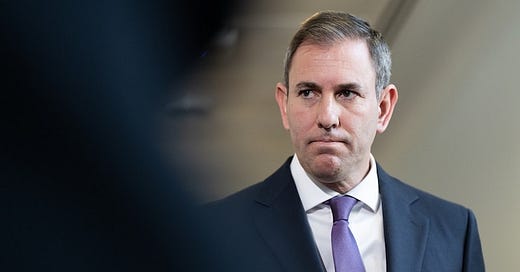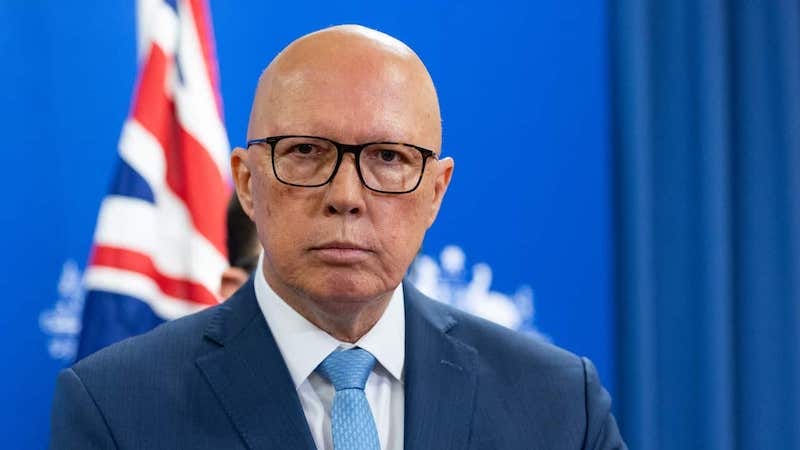The economy is improving but can Labor sell the good news?
The Coalition doesn’t have much to offer but it’s also a question of whether the government can harnessing the better economic news into a coherent message that appeals to the electorate.
The Australian economy has shown signs of meaningful recovery, shifting away from a per capita recession – for nearly seven years, covering most of the final years of the Morrison government and the first two and a half years of the Albanese government, there wasn’t much room for economic optimism yet, the current trajectory suggests a marked improvement, backed by several important indicators: inflation has fallen dramatically, interest rates have eased (slightly), employment has strengthened, and incomes are gradually rising.
Federal Treasurer Jim Chalmers has promoted this situation as a “soft landing”, also suggesting that it’s an opportunity to stabilise growth without subjecting the community to the harsh elements of an economic recession. Pointing to a range of factors that many nations have struggled to achieve simultaneously – reducing inflation, raising wages, lowering unemployment and reducing government debt – but which Australia has, Chalmers highlighted the importance of both public and private sector growth in this equation, which has provided some momentum within the Australian economy.
The timing could not be more critical for a government seeking to leverage good economic news. While the economy is far from reaching peak performance, it has certainly improved from the uncertainty of a few years ago, and this upward trend offers a good political backdrop for the Labor government: a government in office generally benefits from positive economic sentiment in the lead-up to an election – not always, but on most occasions – provided it can persuade the public that the gains are genuine and sustainable.
In this respect, the Albanese government seems well positioned to capitalise on recent data: inflation still needs to come down further for most people to truly feel relief in everyday costs – where prices rarely revert to cheaper levels but instead rise more slowly – but the gradual easing in cost-of-living pressures adds credence to the political message pushed by the government that things are “turning around”.
In contrast to past governments that have been accused of inflating or misrepresenting Australia’s economic figures – the Morrison government was a specialist at this – the current narrative is supported by the data. Inflation was at a peak of 7.8 per cent in December 2022, the current figures are 2.4 per cent. Interest rates – which commenced increasing after the peak of COVID in 2021, reaching 4.35 per cent in November 2023, has eased to 4.1 per cent. The employment-to-population ratio increased to a record high of 64.5 per cent in December 2024, and wages have grown 3.5 per cent over the past 12 months according to the wage price index, after going backwards by 3.4 per cent in the five quarters before that.
Consumer prices for everyday essentials are still causing anxiety for households, but there are broader signs of structural support, from slight reductions in interest rates to more modest increases in the price of basic goods. This alignment of positive indicators provides the government with an opportunity to craft a strong economic message: lower inflation, manageable interest rates – not great, but manageable – and the potential for wage increases that can create an environment that benefits workers and businesses alike. While Australia is not entirely out of the woods, this improved outlook provides some optimism that resonates well beyond the political class. The electorate, if convinced that better economic circumstances are on the not-too-distant horizon, might reward the government in upcoming elections.
That remains the central question though: how effectively can these numbers be communicated so that voters genuinely believe in the changes they are seeing, not just in abstract economic data but in their day-to-day lives? If the economy continues its recovery, the government’s ability to merge economic facts with a compelling narrative could set the tone for the next election campaign. It really is a matter of whether this government is capable of harnessing the better economic news into a coherent message that appeals to the electorate.
The Coalition and media allies will always derail Labor’s good-news economy
Despite the emerging narrative of Australia’s economic improvement, a predictable wave of conservative media coverage has centred on discrediting every optimistic data point. Whenever interest rates drop or GDP figures rise, conservative media commentators aligned with the Coalition cast doubt, demanding that rates should be even lower, or that growth needs to be even faster. This cycle repeats itself on nearly every metric: an improvement in employment numbers is dismissed for being not large enough, and news of easing inflation is minimised by comparing it unfavourably to conditions in other countries such as New Zealand or Canada. If the Australian economy second in the International Monetary Fund’s world budget management rankings – not good enough – why isn’t it number one?
While such criticism can be expected from an opposition party seeking to undermine a government’s achievements, the challenge for Labor is that it faces a media environment only too willing to amplify these disparaging media narratives, narratives that are never pushed whenever the Coalition is in office, even when the economic figures are far worse.
When Australia recently exited the per capita recession – a rarely-used and nuanced measure that reflects population numbers relative to economic expansion – this prompted a new twist in the cycle of negativity. Media outlets reluctant to concede any genuine upturn then pointed to government spending or other peripheral factors that ended this per capita recession, unwilling to acknowledge improving fundamentals. Leading the charge was Shadow Treasurer Angus Taylor, who then inexplicably denied that Australia has moved out of a per capita recession – even though the evidence and facts clearly stated that this was the case – with no stronger reason than a desire to sustain his narrative and score political points using falsehoods.
Ultimately, public sentiment will hinge on whether people in the electorate experience better day-to-day conditions. If Australians can be convinced that their household finances are improving and their communities are stabilising, it may be game over for the Coalition’s electoral ambitions, especially given the unpopularity of the leader of the opposition, Peter Dutton. Certainly, his unpopularity ratings mirror the unpopularity of the Prime Minister, Anthony Albanese, but it’s mirrored in a different way.
Frantic attempts by the media to humanise him – through smiling photo-ops or puff-piece profiles highlighting his personal life – have done little to mask questions about his extensive property portfolio, share tradings and a disconnect from the ordinary struggles of the electorate, more recently highlighted when Dutton left Brisbane during the onset of Cyclone Alfred to appear at a fundraising event at the Sydney home of hospitality mogul Justin Hemmes, an event which raised over $500,000 for the Liberal Party, or his recent attempts to magnify the issues of terrorism and anti-Semitism.
Voters who find themselves stretched thin by mortgage pressures or rising rents are likely to resent any suggestion that owning more than two dozen properties is just par for the course: it’s not. Or jetting off to a political fundraiser in Sydney, rather than be with his community in Brisbane during a time of need. Such dissonance makes it increasingly difficult for Dutton and his allies in the conservative media to craft a compelling alternative story, one that’s capable of overriding the growing perception that the Australian economy, and the daily lives of its citizens, are on the mend.
Big promises and policy battles
As momentum builds toward the next federal election, both major parties are honing their messages and policy offerings. The Albanese government’s strategy has centred on social services and education, highlighted by recent announcements such as major boosts in Medicare funding and a new $5 billion investment to support public schools in New South Wales. In contrast, the Coalition unveiled a $3 billion plan to acquire 28 additional F-35 fighter jets, a move designed to emphasise its national security credentials and feed into a likely scare campaign based around China – even though these jets would offer no resistance against the Chinese military in the unlikely event of a conflagration and, more importantly, offer little relief to families more concerned about cost of living pressures or health and education for their children.
The Liberal Party is lifting heavily from the American conservative playbook, with ideas ranging from reducing the public sector, to ending work-from-home arrangements. Dutton’s vow to mandate a full-time office return for public servants, mirroring steps taken by Donald Trump in the United States, has already proven to be contentious. Not only would such a policy clash with current workplace flexibility trends – and a federal public service agreement which is in place until 2027 – but it also fails to address the broader macroeconomic benefits of hybrid work, ranging from environmental gains to enhanced employee satisfaction and productivity.
This stance is primarily a response from discontented property owners who once enjoyed lucrative rents from shops and offices in central business districts all around the country, yet this response risks alienating everyday Australians who have embraced remote and hybrid work. It’s a short-sighted attempt to gain favour and support from influential business groups and donors, rather than a policy that meets modern social and economic realities.
Faced with a government enjoying an increasingly optimistic economic narrative, the Coalition’s scattershot attacks on Labor’s initiatives may do little to convince an electorate that sees greater value in improved healthcare, better-funded schools, and rising economic indicators than in flashy military contracts. Certainly, the fear and loathing pushed forward by Dutton and the Liberal–National Party does resonate with some parts of the electorate but, for a political leader, there has to a lot more than frightening the community at every opportunity and hoping everything else will just fall into place.
For a public more concerned with whether flexible work arrangements can persist than with whether toothpick-scale jets will fend off a Chinese superpower, the Coalition’s campaign planks are out of touch and increasingly negative. In the end, as voters weigh tangible policy wins against ideological posturing, the gulf between promising social investments and recycled talking points from across the Pacific could determine who prevails at the ballot box.
Will Dutton’s Trump-style blueprint resonate with the electorate?
Dutton has clearly aligned himself with the rabid reactionaries within the current Republican Party administration in the U.S. but is this the recipe for electoral success the Liberal Party is hoping for? These ideas originate from powerful American billionaires and Chicago-school economics, whose overriding priority is to reduce taxes and strip back public services – more or less implemented by the Liberal Party ever since the Howard government was elected in 1996 – initiatives that benefit major corporations but leave everyday citizens footing the bill.
If these policies were to fully take root in Australia, the effect could be a further shift away from equitable funding mechanisms: imagine adding more regressive taxes like the GST or maintaining out-of-reach education costs through measures akin to America’s student debt system, as if Australia’s HECS system isn’t bad enough. Neoliberalism has failed across the world and economies are seeking different solutions in the 2020s and beyond, yet the Liberal Party is promising to implement even more neoliberal policies that work against the interests of the public.
The worry is that Australia, once a global leader in accessible healthcare, affordable higher education, and robust social security and support, risks discarding these achievements for a model that entrenches inequality and fosters a lifetime of indebtedness for those unable to pay. Dutton’s enthusiasm for reactionary American-style policy – where everything from healthcare to education is monetised – reveals a lack of originality and a disregard for Australia’s own proven successes. While it may play well with certain segments of the community and the Liberal Party’s donor base, the broader electorate will question whether Trump-era policies, riddled with social divisiveness and economic disparities, are truly suited to Australian conditions.
In an environment where the Albanese government is highlighting investments in health and education, the Liberal Party’s drift toward an Trump-style blueprint raises pressing questions: is this push to replicate Trump’s tactics really about governance, or is it simply a matter of political grandstanding that serves the few at the expense of the many?













The government has a great message to tell.
'Better days are here again'.
Don't risk ruining the recovery by voting for the LNP, who caused many of the problems we have taken 3 years to fix.
I bet Paul Keating would be after Dutton like a rat up a drain pipe.